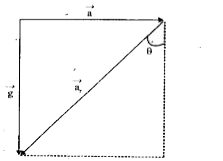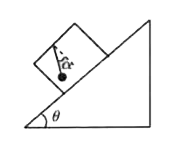Assertion: A simple pendulum is hanging from the ceiling of a compartment of a train. It is observe that the string is inclined towards the rear of the train.
Reason: The train must be deaccelerating.
If both Assertion and Reason are true and the Reason is the correct explanation of Assertion.
If both Assertion and Reason are true but Reason is not the correct explanation of Assertion
If Assertion is true but the Reason is false
If both Assertion and Reason are false
The correct Answer is:A

The string will be vertical if the train is at rest or uniform motion became the only acceleration acting on the bob would then be the acceleration due to gravity. The string is inclined along the direction of the resultant of the acceleration →a of train acting in the horizontal direction and the acceleration due to gravity →g acting vertically downward, as shwon in the figure. The vector →a is the resultant of vectors →a and →g. Hence the string is inclined opposite to the direction of the acceleration of the train. Hence the train must be haivng -ve acceleration or retardation.
Similar Questions
Knowledge Check
A simple pendulum hangs from the roof of a train whose string is inclined towards the rear of the train. Then the train is
Aat restBmoving with uniform velocityCmoving with uniform accelerationDmoving with uniform retardation.A simple pendulum suspended from the ceiling of a trans has a time period T when the train is at rest. If the train is accelerating uniformly at a then its time period
AincreasesBdecreasesCunalteredDbecomes infinityA simple pendulum is suspended from the ceiling of a train which is moving with an acceleration a .The angular of inclination of the pendulum from the vertical will be
A90∘B0∘Ctan−1(ag)Dtan−1(ga)
A train is travelling at a constant speed u around a circular track of radius R. A simple pendulum of length L and mass m is suspended from the ceiling of the compartment of the train. IF the tension in the string of the pendulum is T, then find the time period of oscillation.
View SolutionA ball hangs from a string inside a rail road car moving along a straight track. The string is observed to be inclined towards the rear of the car making a constant small angle with the vertical. It shows that the car is
View SolutionA simple · pendulum of length L is hanging from a rigid support on the ceiling of a stationary train. If the train moves forward with an acceleration a, then the time period of the pendulwn will be
View SolutionA pendulum suspended from the ceiling of a train has time period T when the train is at rest .When the train is accelerating with a uniform acceleration ,the time period will
View SolutionAa simple pendulum is suspended from the ceiling of a vehicle which moves down an inclined plane o inclination Θ. The period of oscilation of the pendulum is
View Solution

